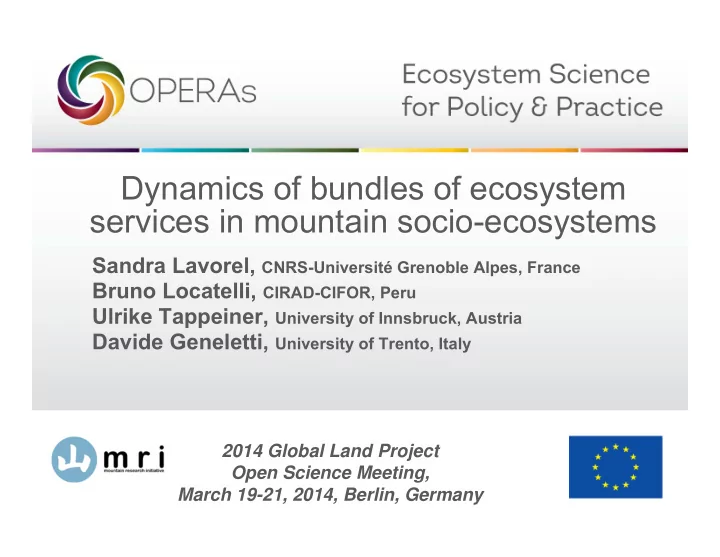

Dynamics of bundles of ecosystem services in mountain socio-ecosystems Sandra Lavorel, CNRS-Université Grenoble Alpes, France Bruno Locatelli, CIRAD-CIFOR, Peru Ulrike Tappeiner, University of Innsbruck, Austria Davide Geneletti, University of Trento, Italy 2014 Global Land Project Open Science Meeting, March 19-21, 2014, Berlin, Germany
Ecosystem service bundles • “Sets of services that repeatedly appear together across space or time” (Raudsepp-Hearne et al. 2010) • Useful for identifying synergies and trade-offs and improving landscape management • Generally defined though analysis of • spatial concordance (Raudsepp-Hearne et al. 2010) • social preferences (Martín-López et al. 2012) Less attention paid to temporal co-variation of services (Holland et al., 2011)
Objectives • To develop a typology of temporal trajectories of ecosystem service bundles • From published case studies for mountain regions • To illustrate this typology with a few detailed case studies • Example from the French Alps
Methods • Case studies identified through literature search • Mostly in Europe (8) and Asia (5). • Few in America (3) and Africa (1) • Typology of ecosystem dynamics built with cluster analysis Elevation (m) 0-500 500-1000 1000-1500 1500-2000 >2000
6 types of ecosystem service dynamics 1. Agricultural frontier More crops More good Less regulation production services 2. Trees at all costs More trees 3. Protected for No change in regulation cultural services More regulation services 4. Human-shaped but Decrease in Less food decreased managmt cultural services production More cultural 5. Museum and park services 6. Multifunctional Shifting food More reg/cult landscape production services
1. Agricultural More crops frontier More good Less regulation 2. Trees at all production services More trees costs • Mostly in developing countries • Drivers: population growth, demand for food, timber or carbon (but also land abandonment) • Agricultural frontier : More agricultural products, less regulation services • Nepal (Bahadur 2012) , Tian Shan in China (Feng et al. 2012) … • Trees at all costs: Forest expansion is not always associated with increasing services trade-offs between forests and watershed services • Ex: Chile (Geneletti, 2013), Ecuador (Farley, 2007) , Taihang Mountains in China (Yuan et al., 2012)
Less food More cultural 5. Museum and park production services • Transition towards a landscape not producing any goods but used for recreation and valued for emblematic landscapes and values. • Drivers: socio-economic and policy changes and new demand for services leading to shift from primary to tertiary activities • Cantabrian Mountains in Spain (Morán-Ordóñez et al., 2013); several nature- dominated mountain regions of Europe (Haines-Young et al., 2012)
Historical dynamics of land use and ecosystem services at Lautaret, French Alps Historical trajectory of land use Ecosystem service models based on plant and microbial traits Management intensity Management intensity Start of crop conversion End crops Mowing cessation Old cadastral maps, aerial photos and Lavorel et al. J.Ecol. 2011, ethnobotanical analysis – Girel et al. 2010 Grigulis et al. J. Ecol. 2013
Lautaret: Transition to Multifunctionality until the 1970’s Regulating (soils) Regulating (carbon) Regulating (water quality) Provisioning (fodder) Cultural Regulating (water quantity/regularity) Provisioning (crops) 1930 1970 2010 “Abandonment” type • Emigration to cities. Shift in farming systems from self-sufficiency to livestock production, allowing for more regulation and cultural (less agricultural production, more regulation, less cultural) services of the landscape • Other examples in Switzerland (future scenarios) (Briner et al. 2013) DESCRIBE DRIVERS
Lautaret : Transition to Human-shaped but decreased management since the 1970s Regulating (soils) Regulating (carbon) Regulating (water quality) Provisioning (fodder) Cultural Regulating (water quantity/regularity) Provisioning (crops) 1930 1970 2010 “Multifunctional” type 6 • Mechanisation and continued emigration. Extensification of livestock (shift in agricultural farming practices : production, more • Benefits for regulation services services) • But loss of cultural services produced by traditional management • Trend exacerbated under scenarios of extreme climate change DESCRIBE DRIVERS (Lamarque et al. 2014) • Other example: in the UK (extensification scenario) (Reed et al., 2013)
From historical trajectories to future scenarios of climate and land use change Extreme climate change 1970’s - Multifunctionality Loss of production and cultural services Restriction to regulation services Carbon sequestration Soil fertility Water quality Plant Green diversity biomass Litter mass Flowering onset 1996-present Forage quality Human-shaped, decreased management Present or moderate climate change Human-shaped, decreased management Lamarque et al. 2014
Discussion and Conclusion • Caveats of the typology: • Few papers • Papers study different sets of services • A service may be overlooked because it is not locally relevant, it does not change, or authors are not interested • A typology of generic value ? Needs to be tested for other socio- ecosystems, especially in naturally constrained biomes (drylands, arctic tundra…) • Predictive value for future trajectories in response to climate and socio- economic change
Thank you! sandra.lavorel@ujf-grenoble.fr bruno.locatelli@cirad.fr
Lautaret : summary of historical trajectory in ecosystem service bundles Regulating (soils) Regulating (carbon) Regulating (water quality) Provisioning (fodder) Cultural Regulating (water quantity/regularity) Provisioning (crops) 1930 1970 2010 2030 “Multifunctional” “Human-shaped, decreased management” DESCRIBE DRIVERS DESCRIBE DRIVERS
Recommend
More recommend